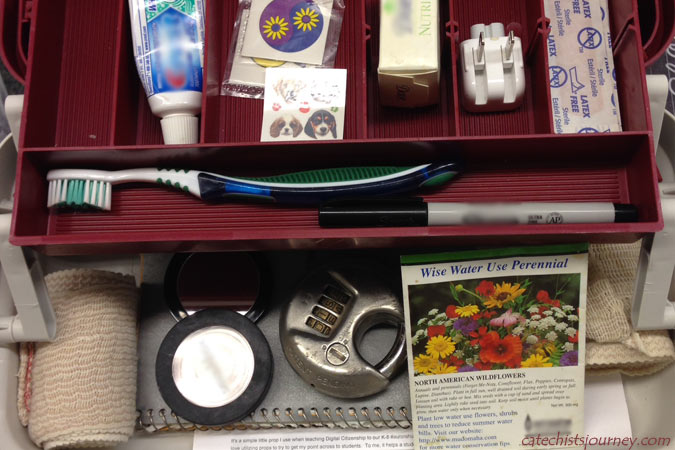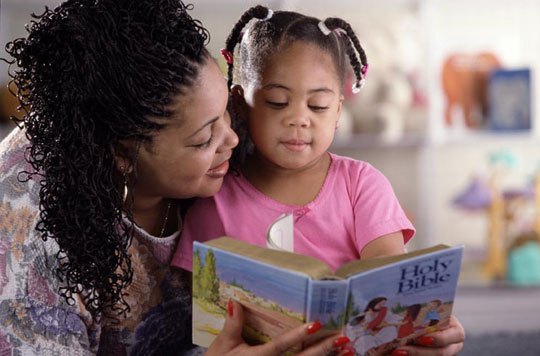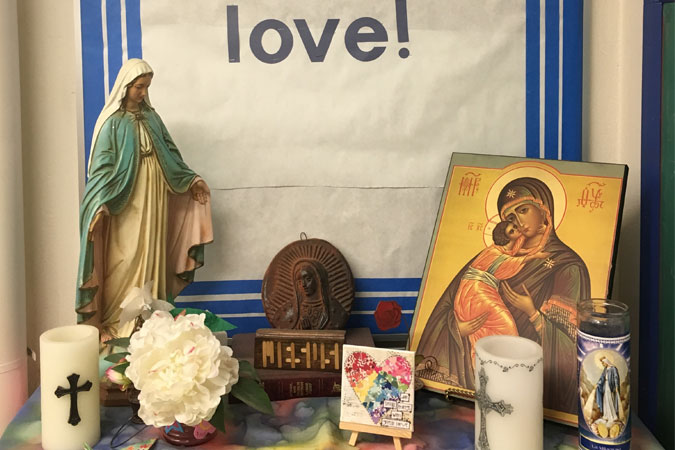
Students use digital devices so frequently that the Internet has become a part of their everyday life, both at school and at home. With students spending more of their free time on these devices, more questions come up in my class about the Internet. While we cover the topic of Internet safety as part of our Safe Environment Training at fourth grade, this should be an ongoing topic with our students.
I adapted an idea from my friend Craig Badura, who works at a school in a small town in Nebraska. He wanted to impress upon his students good practices for using the Internet; I want to do the same thing, but I want my students to look at these practices through the eyes of their faith. I begin by reminding them that “God created humankind in his image / in the image of God he created them.” (Genesis 1:27) This is still true when we are on the Internet.
I began by borrowing my son’s tackle box. In this box, I placed items to remind my students that every time they post something on the Internet—be it a comment or a picture—they should keep in mind the Golden Rule: “Do to others as you would have them do to you; for this is the law and the prophets.” (Matthew 7:12) I call this tackle box our “Digital Citizen Kit.”
This kit contains items that show the children how to interact with one another when they are online. Each item has a story to tell:
- A tube of toothpaste: It’s very difficult to put toothpaste back into the tube. I tell my students that they should always keep this in mind. You can’t take back anything you post on the Internet.
- Temporary tattoos: I explain that a tattoo is very difficult to remove, just as a comment or picture online is difficult to remove.
- Soap: I remind the children that a bar of soap keeps them clean; when they type a comment in response to a blog post, they should keep it clean.
- A plug: A plug is used to connect with the Internet. I remind them to unplug and disconnect from the Internet and keep balance.
- Bandages: A bandage is used to cover and help a hurt heal. I tell the students that sometimes we make a mistake online. When we do, we should seek forgiveness and healing.
- A large bandage wrap: This is used for bigger hurts. I remind the children that if a mistake was made on the Internet or a problem is unable to be solved on their own, an adult can help them figure out how to solve it. They never have to solve the problem on their own; an adult is always available to help.
- A mirror: Just as a mirror is used to check how one looks, I explain that when posting a website comment, the children can take a look at their expression. Their expression can show if they are being kind.
- A toothbrush: This is a personal item that is not to be shared. I explain that it was bought for them by their parents. Similarly, when they have an account that has a password, they should never share the password. The only people that should have this password are their parents.
- A permanent-ink pen: We cannot erase the words written with this pen. I remind the students that anything they write online can’t be erased.
- A padlock: This is used to secure an item. I tell students that when they come up with a password, they must make it strong to protect their account.
- A packet of flower seeds: Flower seeds, with the right combination of good soil, water, and sun, will grow into beautiful flowers. I explain that we should take the written word, the recorded voice, and photographed images and make them a beautiful gift for all.
Finally, Pope Francis commented many times in his World Communications Day message that the Internet is a gift from God. He reminded us that:
The internet can help us to be better citizens. Access to digital networks entails a responsibility for our neighbour whom we do not see but who is nonetheless real and has a dignity which must be respected. The internet can be used wisely to build a society which is healthy and open to sharing.
This kit has a lot of parts, and it may seem like a lot of things to remember. But everything in the Digital Citizen Kit boils down to being kind: “Be kind to one another, tender-hearted, forgiving one another, as God in Christ has forgiven you.” (Ephesians 4:32)
How do you teach students in your classroom to be good digital citizens? How do you impart the importance of being kind on the Internet?





Excellent, interactive, creative, powerful! Thank you, Barb!
Thank you, Christina! It’s great for all ages and a reminder to all of us to keep in mind when we post anything on the internet.
This is fantastic Barb! I teach this same topic and anticipate it being an engaging subject with your relevant example.
Thank you for sharing this!
Thank you, Anne! This is one of my favorite lessons with my 3rd graders. I think tying in our Catholic faith with these items make the lesson stick. Good luck putting your kit together!